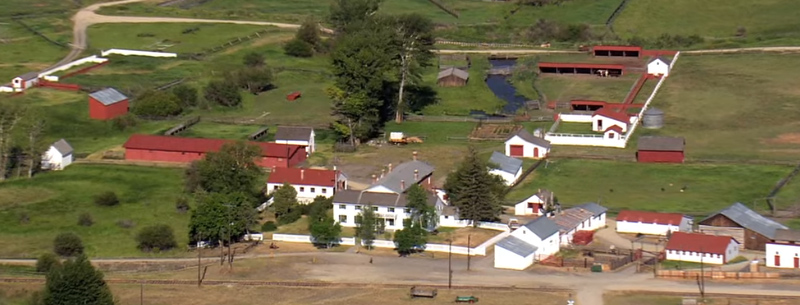The West is full of cowboys. At least, that’s an idea commonly held by people from east of the Mississippi to the Middle East. At Grant-Kohrs Ranch in Deer Lodge, Montana, visitors from around the world get a glimpse of the true story of trail drives, roundups, and cowboys. The reality is as impressive as the myth. Once the headquarters of a ranch which ranged cattle over ten million acres in four states and Canada, Grant-Kohrs Ranch NHS preserves 87 original historic structures and over 35,000 artifacts on fifteen hundred acres.
Canadian Johnny Grant settled in the valley in the late 1850s, where he found ample grazing for the fine cattle he traded with immigrants along the Oregon Trail near present-day Pocatello, Idaho. Grant could trade one healthy cow for two cows too weakened by the long westward trek to continue on the harsh journey. Trailing them north to Montana’s grassy valleys by easy stages, he would rest and fatten the animals over the winter, then trail them south again to trade with the next season’s immigrants.
During Montana’s gold rush, in the 1860s, Grant sold his ranch to German immigrant Conrad Kohrs. Kohrs had walked from Idaho to Montana to seek gold but soon learned there was profit to be made selling beef to his fellow miners. His butcher business led to ranching, as he needed a place to keep his stock in trade. Kohrs and his half-brother and partner Johney Bielenberg made the ranch the largest in the state. It was preserved intact by Kohrs’ grandson, Conrad Kohrs Warren, who also raised cattle and horses.
Authorized by Congress on August 25, l972, the ranch commemorates the open range cattle era of our nation’s history. Visitors can tour the elegant historic mansion and attend programs at the blacksmith shop and chuck wagon. The ranch raises cattle and hay and does some work with draft horses.
Grant-Kohrs Trivia
- All the cattle trailed out of Texas during the heyday of the open range would make a solid column seven cows wide-stretching 1,329 miles from Fort Worth, Texas to Billings, Montana.
- The average cowboy of the 1800s was typically a teenager or in his early 20s.
- There are about 37,000 registered cattle and horse brands in Montana today, and 98 percent of Montana cattle are still branded in the traditional way.
- Cowboys working for Conrad Kohrs came from as far away as France, Ireland, and Bavaria.
- The average Montana horse eats 2 tons of hay each winter. The average Montana cow eats 1 1/2 tons – her four stomachs help her make better use of the hay than the horse with its single stomach.
- In eastern states where there is ample rain, two cows can be raised on a single acre. In the arid west, there are areas where conditions are so harsh it takes 250 acres to support a single cow and calf.
Grant-Kohrs Attractions
- Draft horse plow days, May 15-16, 2004. Teamsters from around Montana will gather to demonstrate their skills with draft horses and mules.
- Western Heritage Days, July 10-11, 2004. Special programs range from musicians to branding to chuckwagon cooking, including a chili cook-off. Admission is free.
- Holiday Open House, December 5, 2004. The Kohrs ranch house becomes even more elegant with the addition of a Victorian tree and other special displays. Wagon rides, hot cocoa, cookies and children’s programs are also featured.
